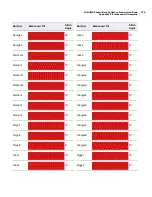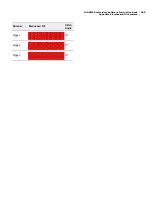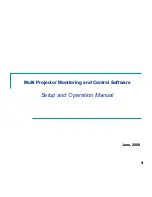
JANOME Embroidery Software Instruction Book
Glossary
293
embroidery production on
oversized items and production
orders of very large quantities.
Screen calibration: You need to
calibrate your monitor so that
designs at 1:1 scale appear at real
size. Do this when you first install
EasyDesign, whenever you change
your monitor, or adjust your
monitor’s horizontal or vertical
controls.
Screen resolution: See
Pixels
.
Scroll bar: The bar at the bottom
and right edge of a window whose
contents are not entirely visible.
Each scroll bar contains a small
box, called a scroll box, and two
scroll arrows to allow different
types of scrolling.
Security Device: See
Dongle
.
Select: To highlight an object or
group of objects for the purpose of
editing. Only selected items can be
edited.
Selection handles: Eight small
squares that appear symmetrically
at the corners and edges of a
selected object. Use them to
position and resize objects. See
also
Rotation handles
.
Sequence: See
Stitching
Sequence
.
Sequins: Sequins, also known as
‘spangles’, are small plastic disks
with a hole in the centre. The
spangles are stored on rolls, each
one joined to the next by a weak
link. They are stitched onto fabric
by placing a spangle in front of the
needle whilst needles are out of the
fabric.
Serial port: A connection point
on a computer where you plug a
serial communications device such
as a modem. PC serial COM ports
are male connectors, and can be
either 9-pin or 25-pin. They are
named COM1, COM2, COM3, etc.
The number of available ports
limits the number of devices you
can connect. If additional ports are
required, you can add them.
Multi-port serial cards can also be
used.
Serial Port Setup: Here you can
adjust Baud, Data Bits, Stop Bits,
Parity values. These settings must
be identical to those of the
embroidery machine. The type of
handshaking must match the type
of cable you are using.
Short stitch: Digitizing technique
that places shorter stitches in
curves and corners to avoid an
unnecessarily bulky build-up or
stitches.
Shortcut key: A key stroke or a
series of keystrokes you can use to
perform a task instead of using the
mouse. For example, Ctrl+C
actions the Copy command.
Sizing handles: See
Selection
handles
.
Skew handles: See
Rotation
handles
.
Slow Redraw: Use to redraw
your design slowly. Slow Redraw
lets you view the stitching and
color sequence of a design in slow
motion.
Software: Programs, such as MS
Windows and JANOME Embroidery
Software, which run your
computer.
Spangles: See
Sequins
.
Specialty threads: Threads
designed for effects such as shine,
glitter, iridescence or thickness.
The threads often are made from
synthetic materials including
rayon, mercerized cotton, metallics
and textured nylon.
Stabilizer: Also know as
‘backing’, stabilizers are woven or
non-woven materials used
underneath the item or fabric being
embroidered to provide support
and stability. It can be hooped with
the item or placed between the
machine throat plate and hooped
garment. Available in various
weights and types such as
cut-away, tear-away and
wash-away (soluble). The more
stitches your design has, the more
backing you will need. Professional
embroiderers use tear-away
stabilizers for woven fabrics and
cut-away stabilizers for knits. See
also
Topping
.
Status bar: Provides information
about the whole design: number of
stitches, position of the design (X,
Y), number of colors (C), number
of stops (S), etc.
Stitch: A stitch is a single needle
penetration. Also refers to thread
laid down from one needle
penetration to the next.
Stitch angle: The stitch angle is
the angle the overall stitching
follows within a shape. The shape
may have a fixed stitch angle – e.g.
45° to the horizontal – or multiple
stitch angles.
Stitch bunching: Standard stitch
spacing is calculated at the outside
edge of a shape. With sharp
curves, spacing which provides
adequate coverage on the outside
edge may cause bunching along
the inside edge. This may cause
thread breakage when stitching
out.
Stitch count: Stitch count refers
to the number of stitches in a
design. In EasyDesign one stitch is
considered one machine
revolution. See also
Design
properties
.
Stitch density: The number of
stitches per given area (or stitch
lines per distance in a fill).
Stitch editing: Digitizing feature
that allows one or more stitches in
a pattern to be deleted or altered.
Stitch file: Stitch or ‘expanded’
designs are low-level formats for
direct use by embroidery
machines. They contain only stitch
coordinates and machine
functions. Stitch designs are
generally not suited to scaling
because stitches are not
regenerated during rescaling. See
also
Outline file
.
Stitch length: The distance
between two needle penetration
points. For maximum stitch length,
the length is measured according
to the X and Y co-ordinates,
whichever is greater. Run stitch
length can be set to automatically
vary in order to follow tight curves.
See also
Max/Min stitch length
.
Stitch-Pull: When any stitch is
sewn into fabric the tension in the
thread between needle
penetrations can build up and
result in Stitch-Pull. Stitch-Pull can
cause distortions in your sewn
designs, poor stitch registration
and even the bunching up of fabric.
The amount of Stitch-Pull that
results in your design can be
affected by the following factors:
Stitch Density, Fabric Type,
Summary of Contents for DigitizerPro
Page 236: ...234 Part IX Software Feature Table ...












































